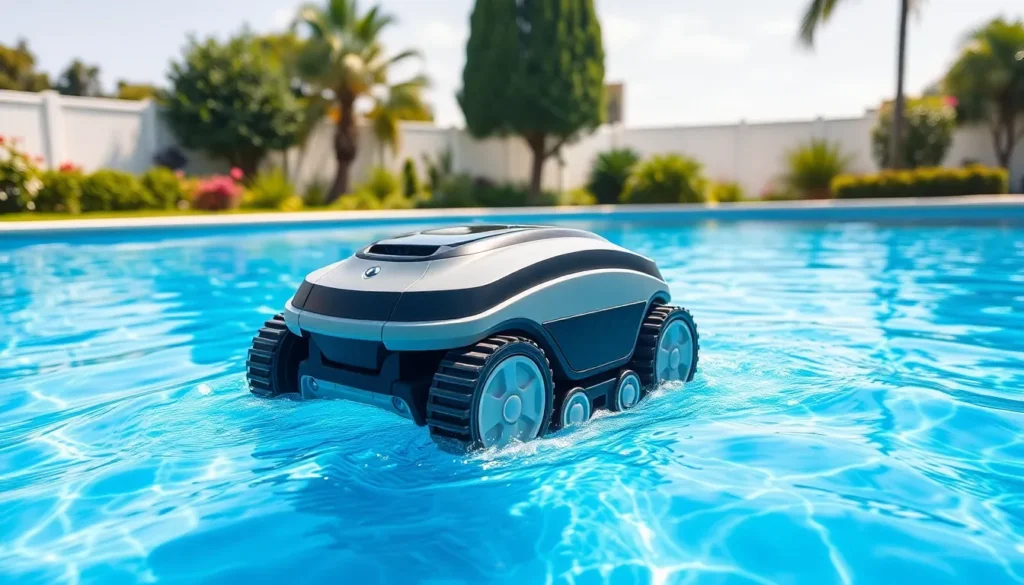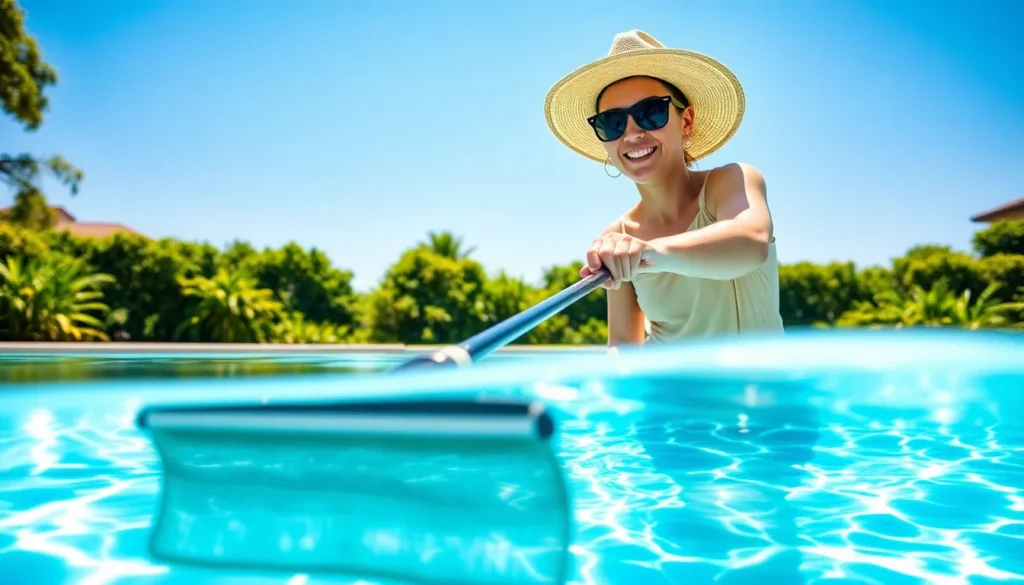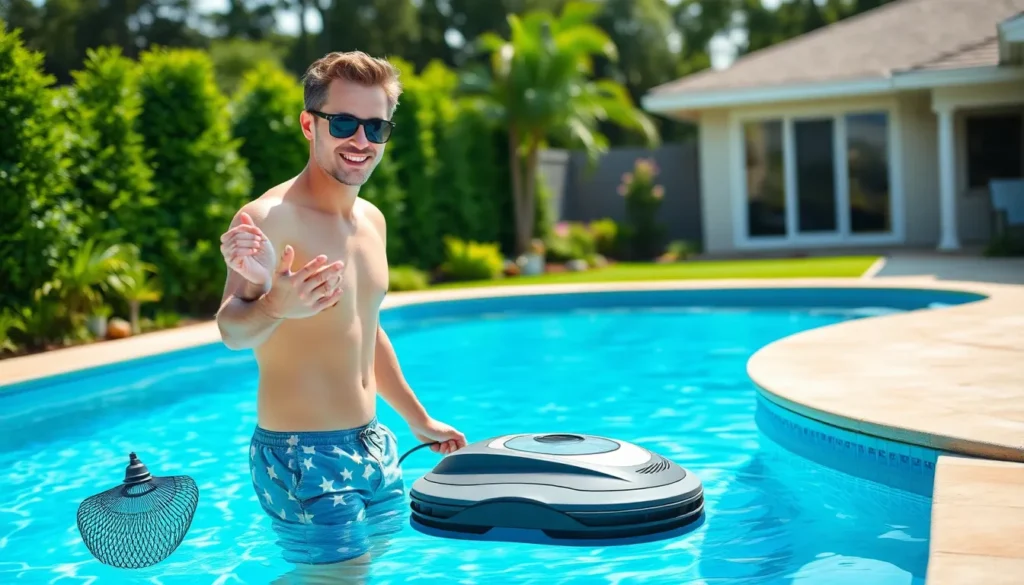Table of Contents
ToggleWhen it comes to pool maintenance, a chemical balancer is like the unsung hero of backyard bliss. Without it, your sparkling oasis could quickly turn into a swampy mess, complete with unwanted guests like algae and bacteria. Nobody wants to swim in a green soup, right?
Overview of Pool Chemical Balancer
A pool chemical balancer ensures water remains clean, clear, and safe for swimming. This product addresses pH levels, alkalinity, and calcium hardness, all essential aspects of pool maintenance. Parameters such as pH ideally range from 7.2 to 7.8, promoting comfort and safety for swimmers. Alkalinity should fall between 80 to 120 parts per million (ppm), preventing pH fluctuations.
Balancing chemicals prevents algae and bacteria growth. Maintaining the right balance stops the development of harmful microorganisms. Test strips and liquid test kits provide specific readings to determine chemical levels accurately. Regular monitoring helps pool owners adjust their approach based on test results.
Calcium hardness directly influences water quality and equipment longevity. It should stay between 200 to 400 ppm to protect your pool surfaces and water features. If hardness is too low, corrosive water can damage equipment. Conversely, high hardness can cause scaling and cloudy water.
Chemical balancers often include platforms like sodium bicarbonate, calcium chloride, and muriatic acid or sodium bisulfate. Each type serves distinct purposes, such as raising alkalinity, adjusting calcium levels, or lowering pH. Pool owners should choose these products based on their specific needs.
Proper usage of chemical balancers enhances water clarity and overall hygiene. Following product instructions guarantees effective results. Regular maintenance and attention to water chemistry cultivate a welcoming swimming environment, reinforcing the importance of a consistent chemical balancing routine.
Importance of Proper Water Chemistry

Proper water chemistry is vital for maintaining a healthy swimming pool. A balanced chemical environment prevents issues that could compromise water quality and swimmer safety.
Impact on Pool Health
Imbalanced water chemistry leads to negative consequences. High pH levels can cause scale buildup, while low levels can irritate skin and eyes. Chlorine effectiveness diminishes if pH is outside ideal ranges, allowing harmful microorganisms to thrive in the water. Regular monitoring of chemical levels protects swimmers and extends the life of pool surfaces. Maintaining optimal alkalinity and calcium hardness further safeguards against corrosion and damage to equipment. A well-balanced pool environment fosters a safe and enjoyable experience for everyone.
Benefits of Using a Chemical Balancer
Using a chemical balancer streamlines pool maintenance efforts. It simplifies the process of achieving ideal pH ranges, which fall between 7.2 and 7.8. Regular use of sodium bicarbonate, calcium chloride, or muriatic acid helps maintain water clarity and hygiene. Cost-effective solutions also reduce the need for frequent water changes, conserving resources. In addition, the enhanced aesthetic appeal of crystal-clear water encourages more frequent use and enjoyment of the pool. Implementing a consistent balancing routine ensures a welcoming atmosphere for swimmers of all ages.
Types of Pool Chemical Balancers
Various types of pool chemical balancers play crucial roles in maintaining optimal water quality. Each balancer serves specific purposes in achieving a safe and enjoyable swimming environment.
pH Balancers
pH balancers help maintain the water’s acidity levels, keeping them between 7.2 and 7.8. Sodium carbonate functions as an effective pH increaser, while muriatic acid lowers pH when it rises too high. These products support swimmer comfort by minimizing skin and eye irritation. Regular testing of pH levels ensures balanced water, contributing to the durability of pool surfaces and equipment.
Alkalinity Balancers
Alkalinity balancers maintain total alkalinity between 80 and 120 parts per million (ppm). Sodium bicarbonate acts as a common alkalinity increaser, stabilizing pH levels against fluctuations. This balance protects pool surfaces and helps avoid corrosion or scaling issues. Monitoring alkalinity regularly aids in achieving consistent water quality, enhancing overall swimming experience.
Calcium Hardness Balancers
Calcium hardness balancers play an essential role in preserving water quality by maintaining levels between 200 and 400 ppm. Calcium chloride effectively increases calcium hardness when necessary, preventing staining and damage to surfaces. Proper calcium levels protect against corrosion of metal components while keeping plaster from deteriorating. Regular assessment of calcium hardness ensures long-term maintenance of pool integrity and swimmer satisfaction.
How to Use a Pool Chemical Balancer
Using a pool chemical balancer involves careful monitoring and application to maintain optimal water quality. Proper implementation ensures a safe and enjoyable swimming environment.
Testing Water Parameters
Testing water parameters is essential for effective pool maintenance. Regular testing indicates whether pH levels are between 7.2 and 7.8, ideal for swimmer comfort. Alkalinity checks help maintain levels between 80 and 120 ppm, preventing fluctuations in water chemistry. A calcium hardness measurement should fall between 200 and 400 ppm to protect surfaces and equipment. Utilization of reliable test strips or liquid kits provides accurate readings. Frequent assessments enable timely adjustments, ensuring a balanced pool environment.
Dosage and Application
Dosage and application of chemical balancers must align with current water conditions. Sodium bicarbonate addresses alkalinity needs by adding approximately 1.5 pounds per 10,000 gallons for a 10 ppm increase. To adjust pH, muriatic acid or sodium carbonate can be used; typically, around 1 quart of muriatic acid adjusts pH in 10,000 gallons. Calcium chloride raises calcium hardness concentration; about 1 pound per 10,000 gallons increases levels by 10 ppm. Dispersing chemicals evenly throughout the pool prevents localized reactions and optimizes effectiveness. Allowing proper circulation post-application ensures distribution throughout the water.
Common Mistakes to Avoid
Failing to test water regularly leads to imbalances in pool chemistry. Regular testing enables timely adjustments to pH, alkalinity, and calcium hardness, ensuring optimal swimming conditions.
Overlooking the specific requirements of each chemical balancer creates inefficiencies. Each product, like sodium bicarbonate or calcium chloride, serves a unique purpose, and users must understand these roles to enhance water quality.
Adding multiple chemicals at once often complicates balancing efforts. It’s wiser to apply one chemical at a time, allowing for proper circulation and reaction before adding another.
Neglecting to read product labels can result in improper dosing. Maintaining the correct dosage ensures effective chemical balance, helping avoid issues like algae growth or skin irritation.
Interestingly, skipping the circulation process after adding chemicals reduces their effectiveness. Proper circulation allows the chemicals to disperse evenly, maximizing their impact on water quality.
Using household products instead of pool-specific chemicals can cause more harm than good. Only pool-grade chemical balancers should be used to avoid unanticipated reactions that may harm surfaces or swimmers.
Underestimating the impact of temperature and weather on chemical levels can lead to unexpected fluctuations. Changes in temperature or heavy rainfall may necessitate more frequent testing and adjustment.
Lastly, ignoring calcium hardness can lead to scale buildup. Maintaining calcium levels within the ideal range of 200 to 400 ppm protects surfaces and extends the lifespan of equipment.
Maintaining a balanced pool environment is essential for both safety and enjoyment. By regularly monitoring and adjusting pH levels, alkalinity, and calcium hardness, pool owners can prevent issues like algae growth and equipment damage. Using the right chemical balancers not only enhances water clarity but also protects swimmers from irritation and discomfort.
Establishing a consistent routine for testing and applying these chemicals will streamline maintenance efforts and ensure a welcoming swimming experience. With proper care and attention to water chemistry, pool owners can create a beautiful oasis that remains inviting all season long.




